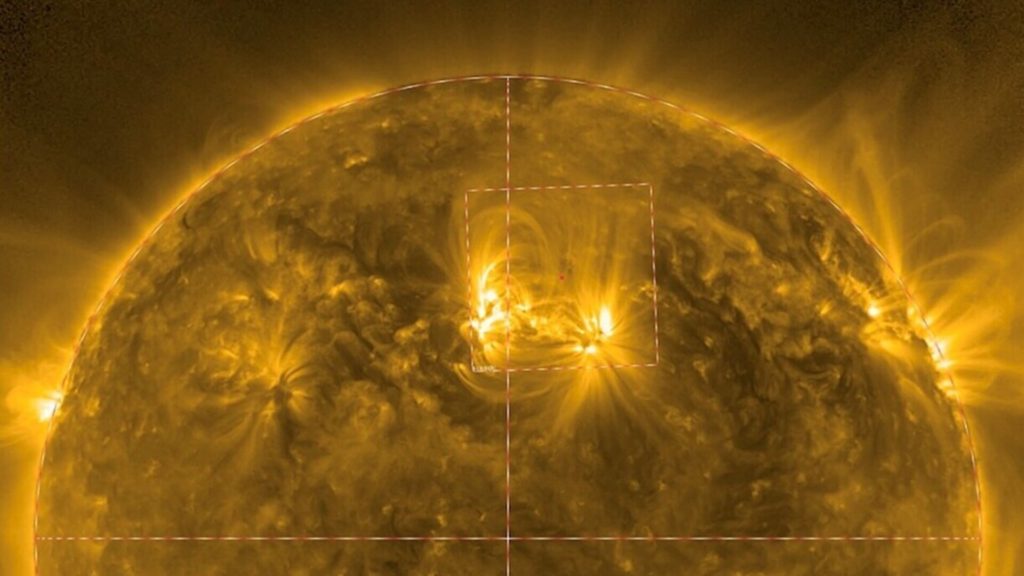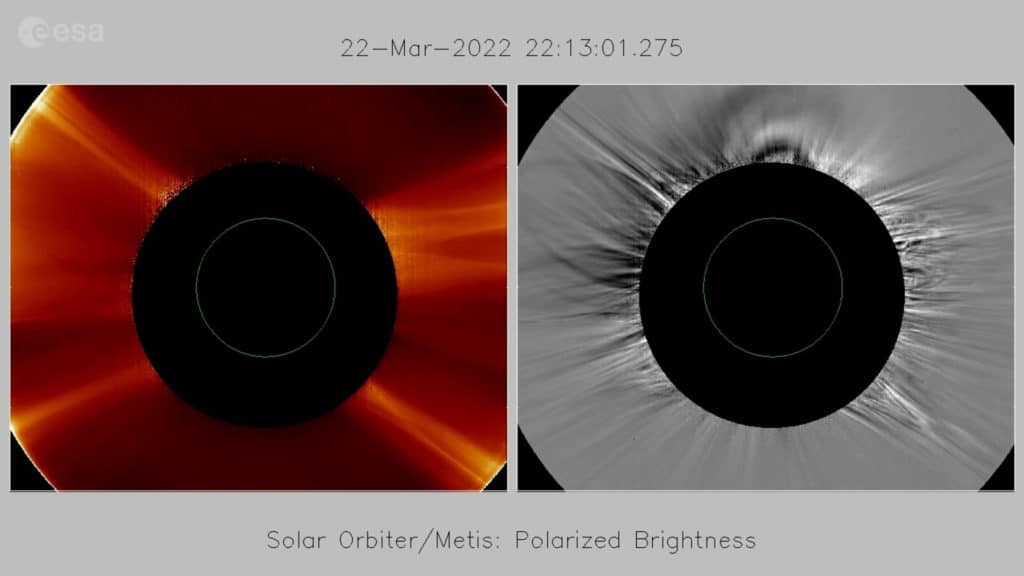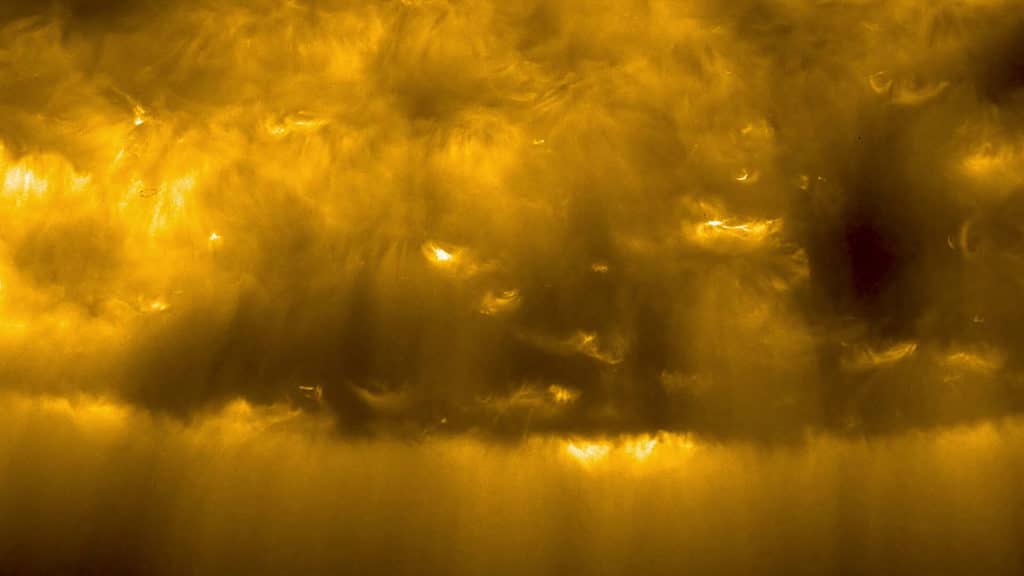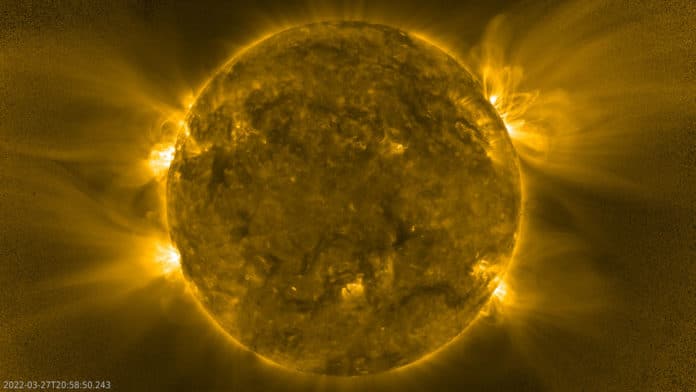On 26 March 2022, ESA’s Solar Orbiter made the closest approach to Sun, known as Perihelion. The spacecraft was inside the orbit of Mercury at a distance of around 48 million kilometers (30 million miles). At that proximity, temperatures reached about 500 degrees Celsius (930 degrees Fahrenheit).
The spacecraft saw the Sun during the approach as we had never seen it before. ESA shares the new observations in images, movies, and data- made by the spacecraft. The observations show Powerful flares, breathtaking views across the solar poles, and a curious solar ‘hedgehog.’
The images are breathtaking.
Solar Orbiter’s space hedgehog
One particularly eye-catching feature was seen during this Perihelion. That feature, for now, is nicknamed ‘the hedgehog.’ It stretches 25 000 kilometers across the Sun and has a multitude of spikes of hot and colder gas that reach out in all directions.

The Extreme Ultraviolet Imager (EUI) on Solar Orbiter captured the image of a solar hedgehog on 30 March 2022 at a wavelength of 17 nanometres.
The temperature of the gases in this photograph is roughly one million degrees. Because the original wavelength detected by the equipment is imperceptible to the human eye, the image has been color-coded.
On 21 March, a few days before Perihelion, the Energetic Particle Detector (EPD) detected a cloud of energetic particles sweeping across the spacecraft. The most energetic of them arrived first, later lower and lower energies.
Javier Rodríguez-Pacheco, University of Alcalá, Spain, and EPD’s PI, said, “This suggests that the particles are not produced close to the spacecraft. Instead, they were produced in the solar atmosphere, nearer the Sun’s surface. While crossing space, the faster particles pulled ahead, the slower ones, like runners in a sprint.”
The Radio and Plasma Waves (RPW) experiment picks up the strong characteristic sweep of radio frequencies produced when particles are emitted. RPW then detected oscillations known as Langmuir waves.
Milan Maksimovic, LESIA, Observatoire de Paris, France, and RPW PI said, “These are a sign that the energetic electrons have arrived at the spacecraft.”
Both EUI and the X-ray Spectrometer/Telescope (STIX), remote sensing instruments on the spacecraft, saw events on the Sun that could be releasing the particles. The team will determine how these observations are all linked.
Magnetic activity
The visible surface of the Sun is known as the photosphere. The Polarimetric and Helioseismic Imager (PHI) and Extreme Ultraviolet Imager (EUI) instruments, on 17 March 2022, took images of this active region of the Sun.
The PHI image (black and white) shows the magnetic polarity at the photosphere, where the Sun’s magnetic field bursts upwards into the solar atmosphere. Black and white represent different magnetic polarities.
The EUI image (colored) reveals the bright, one million degree-hot gas caught in the loops of magnetism that have broken through the photosphere and now reached into the atmosphere. Each loop footprint can be seen to have a different magnetic polarity. The EUI image also shows the ‘lace-like’ network of gas known as coronal mass. It was taken at a wavelength of 17 nanometers, in the extreme ultraviolet region of the spectrum, and has been color-coded because this wavelength is invisible to the human eye.
Composition of the corona
The movie, shared by the Spectral Imaging of the Coronal Environment (SPICE) instrument on the ESA/NASA Solar Orbiter, shows the corona at six different wavelengths of ultraviolet light simultaneously between 21:45 UT 31 March 2022 and 20:29 UT 1 April 2022.

The images show the composition of the corona. Each image has been color-coded because of invisible wavelengths to the human eye. Different species of atoms characteristically emit these wavelengths at different temperatures.
On the top row, the 99 nanometres (nm) image depicts nitrogen at 85 000°C, the 70 nm image depicts oxygen at 100 000°C, and the 75 nm image shows sulfur at 110 000°C. The 76.5 nm image on the bottom row depicts nitrogen at 150 000°C, the 78 nm image depicts both sulfur and oxygen at 160 000°C, and the 77 nm image shows neon at 630 000°C.
Credit: ESA & NASA/Solar Orbiter/SPICE Team
SPICE PI Frédéric Auchère, Institut d’Astrophysique Spatiale, France, said, “This will track the evolution of the composition of the solar wind from the Sun to the spacecraft, and that tells us about the mechanisms responsible for the acceleration of the solar wind.”
Final words
Data from all these instruments will help the science team to tell the story of solar activity from the surface of the Sun out to Solar Orbiter and beyond.

Daniel Müller, ESA Project Scientist for Solar Orbiter said, “It’s almost hard to believe that this is just the start of the mission. We are so thrilled with the data quality from our first Perihelion. It’s almost hard to believe that this is just the start of the mission. We are going to be very busy indeed.”
